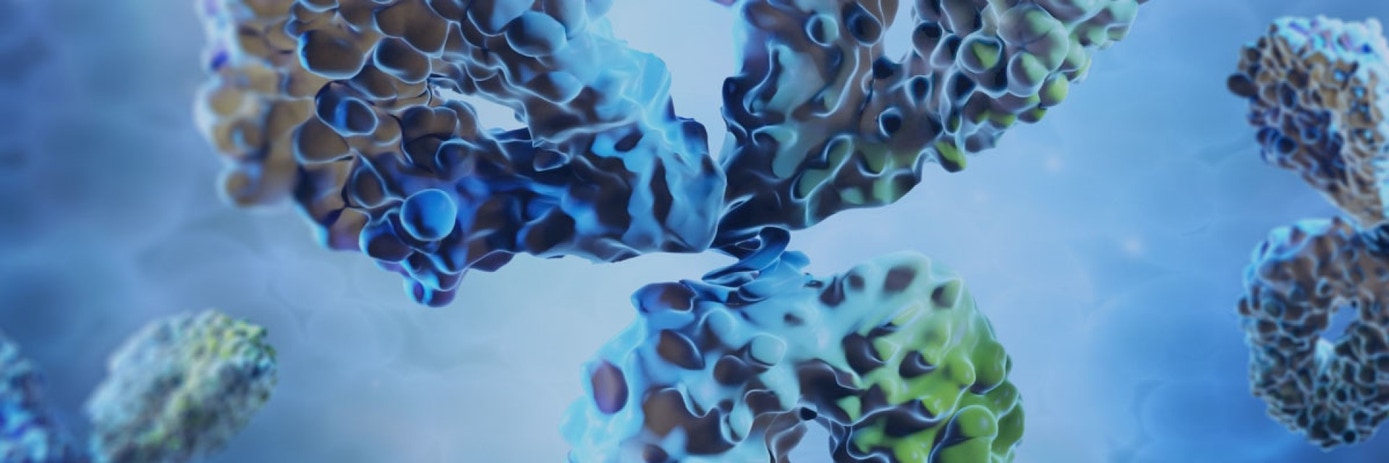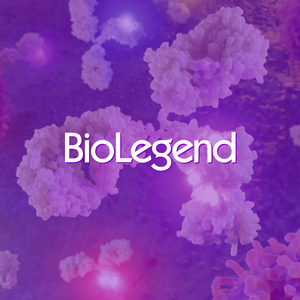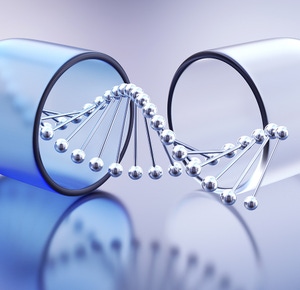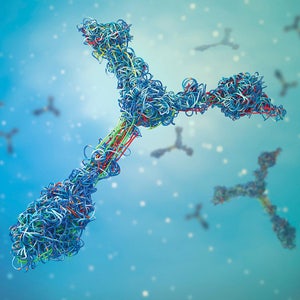

Therapeutic antibody discovery: screening and characterization strategies for the newest classes of therapeutic antibodies
The emergence of bispecific and multi-modality targeting antibody therapeutics is growing, especially in immuno-oncology. Combating the complexity of the tumor microenvironment requires novel therapeutic design. Bispecific molecules provide the ability to selectively turn off and on different modalities or different traits, and properties of the antibodies allow fine tuning of targeted novel biology in a fit-for-purpose manner.
Antibodies have been used as therapeutic entities for 30 plus years, and have increased in complexity and function over time. The next generation of protein therapeutics are multi-specific, where rather than monitoring a single protein interaction, antibodies can be designed to target multiple modalities, such as two or more proteins or cells. Driving this new functionality has been due to the cumulative increase in understanding of the fundamental disease biology and the roles various proteins and cell types play in diseases. Some of the reasons why therapeutics may benefit from an antibody designed with two or more targets, is for faster elimination of a tumor cell, triggering it for cell death. In this case, multi-specific antibodies are a more effective treatment without the need for co-administrating two separate therapeutics. A multi-specific protein therapeutic can also function as an alternative to a cell therapy, an antibody can be engineered with a T cell receptor and a tumor receptor to bring the T cell to the cancer cell, such as the case with BiTE® (Bispecific T cell Engager) antibody constructs.
The emergence of bispecific and multi-modality targeting antibody therapeutics is growing, especially in immuno-oncology. Combating the complexity of the tumor microenvironment requires novel therapeutic design. Bispecific molecules provide the ability to selectively turn off and on different modalities or different traits, and properties of the antibodies allow fine tuning of targeted novel biology in a fit-for-purpose manner. This increased ability to engineer antibody therapeutics with multiple targets allows for higher characterization based on the molecular interactions known to contribute to the overall disease state. In order to reach the stage of engineering a highly effective bispecific antibody, finding a target that offers the potential to elicit the intended therapeutic effect must be thoroughly investigated.
For research use only. Not for use in diagnostic procedures.
To view the full content please answer a few questions
Initial Screening Methods to Identify Primary Hits
There are a number of technologies and applications that can help you build out or identify the antibody clones. These can be anything from hybridoma type screens to phage display, where you undergo multiple rounds of bio-panning. This is a tedious process generally involving iterative rounds of screening or cell culture. To identify antibodies that bind the intended target, an assay with the ability to monitor the antigen-antibody interaction must be designed. Researchers build out a robust and novel screening assay to identify the antibody that displays the desired binding characteristics. Building an assay for robustness allows for efficiency savings within hit identification earlier in the process, which can help to accelerate the development timeline.
In order to get the best binder, there are a number of approaches you can take using different assay formats and platforms. Homogeneous no wash assays are great plate-based assays that allow for the assessment of relative affinities, and for determining the specificity or cross-reactivity of the antibody of interest. There are different types of instrumentation such as surface plasmon resonance (SPR) or bio-layer interferometry (BLI) that look at direct binding interactions and can begin to categorize biophysical properties.
Hit identification is focused on understanding the desired antigen antibody binding characteristics. You want to understand the strength of affinity and understand any additional properties of the antibody that would be important for the therapeutic function. This can be performed using flow cytometry or different Fc mediated effector screening type essays. Screening for the Fc mediated function of your primary hits can help to identify good hits to move forward with in the development cycle. There are many commercial products on the market that will allow researchers to screen for binding of the primary antibody to Fc gamma receptors. If the desired outcome of your therapeutic antibody is to induce cytotoxic mechanisms such as antibody-dependent cytotoxicity, you would want to screen antibodies that bind to the Fc gamma receptors. If your antibody therapeutic is used for an immune checkpoint blockade or functions as a delivery mechanism, and therefore you need a longer half-life, then you would avoid binding to the Fc gamma receptor. In addition, increased binding to the FcRn, which helps antibodies avoid lysosomal storage destruction, increases the half-life of the antibody drug. Primary hits can be screened for binding FcRn using commercial in vitro assays including SPR, Alpha™ bead based, TR FRET, and ELISA™ in order to predict the relative half-life of the antibodies. The more expansive the data gathered from target identification, the better the predictive insight for what measures need to be assessed through various characterization methods.
Challenges in Characterizing and Building Confidence in the Lead Multi-specific Molecule
Building a robust catalogue of assays can be used not only in early discovery for identification and characterization, but also applied downstream in the workflow for future assessments. For bispecific antibodies, developing a strong multiplex assay with the ability to assess the binding to multiple targets at the same time can help to build confidence in the lead molecule. It is important to not only show that the bispecific antibody can bind each of the targets individually, but that simultaneous bispecific binding is possible. High throughput homogeneous in vitro assays such as Alpha bead based or TR FRET sandwich assays, can be used to determine multi-target binding capacity. Adding efficiencies, such as multiplexing, to each step of the overall drug development process allows for both time and cost savings, and the ability to generate well categorized molecules.
Another challenge with bispecific antibody characterization is determining the optimal binding affinity to each of the targets. The same binding affinity to both targets for a bispecific antibody may not be a desired characteristic. Knowing the expression levels of each of the target proteins may help to determine the desired affinity. For example, if a bispecific antibody has high affinity for a target with high expression levels, and low affinity for the other target, the functionality based on expression and affinity binding may not result in the desired therapeutic outcome. Understanding not only binding affinity, but that correlation to potency is also important to investigate because binding affinity does not always translate to potency. In instances of antibody therapeutics causing cytokine storms, antibodies are binding too strongly and eliciting an equivalency of response. The response is observed as a release of cytokines resulting from the intended bispecific antibody triggered cell killing. Cell death releases additional cytokines rendering a cytotoxic state for the overall cell. The strength of binding in this scenario works in opposition to the efficacious functionality of the bispecific antibody therapeutic.
Combining these data with the development of predictive biomarker and cell-based assays can help to build confidence in the lead molecular candidate. Cell models can be developed to target cell surface receptors or to evaluate phosphorylation of a downstream protein in the signalling cascade to determine potentially correlated effects. If methods are established early on in the development timeline, the added context and confidence can help to accelerate the overall process. As in vivo testing begins, adding research assays to monitor immunogenicity may be used to help determine potential clinical impact. By assessing the lead candidate in robust and high performing immunoassays for the detection of biomarker modulation trends, cell-based context, and immunogenicity, predictive information can be included as supportive pharmacodynamic context in the overall characterization of the lead molecule.
Antibody Engineering for Lead Optimization
Understanding the information gathered from a robust characterization evaluation can help to isolate which properties can be fine-tuned to give the best desired biological effect. Antibody engineering techniques are applied to candidates in order to improve characteristics for better desired therapeutic outcomes.
One technique, fragment reformatting can be used to adjust the properties of bispecific antibodies. It can be advantageous to reformat the antigen binding regions of an antibody to change the in vivo properties. Smaller antibodies or antibody fragments such as F(ab)’2, scFvs, VHH can have increased bio-penetration, and reduced immunogenicity. Reformatting can be carried out in a number of ways. In silico modelling such as homology modelling and molecular dynamics can help identify regions or residues that can be changed to impact desired properties.
These changes then drive recombinant expression of a second generation of antibodies. While single amino acid substitutions may seem to represent a minute change in the antibody, these alterations can significantly impact post-translational modifications, such as glycosylation or disulfide bond formation, and lead to shifts in the higher order structure of the antibody. Compared to IgGs, antibody fragments are smaller, can be produced in larger yields from microbial expression systems resulting in lower manufacturing costs and have better pharmacokinetic properties. Antibody fragments have allowed researchers to probe new disease classes that they had not been able to access before, such as brain-penetrating antibodies for neurological indications.
Another technique that can be used to improve hit properties through antibody engineering is site directed mutagenesis. This is the process where a single or a few amino acids are modified. For recombinant expressed antibodies, this can be done by modifying the DNA sequence in the expression plasmid. The amino acid to be modified can be chosen based on the characteristics you want, such as site-specific modifications in the Fc region to eliminate the binding of the antibody to the Fc gamma receptor. The site directed mutagenesis can also be done randomly to try to select for higher or lower affinity binders. Site directed mutagenesis of the DNA plasmid is done using PCR with primers that contain the desired base change, which then can lead to the desired amino acid change in the protein.
Affinity maturation is derived through somatic hypermutation and can be used to improve the characteristics of the primary hit. Somatic hypermutation is the process in which activated B-cells drive mutations in the V-regions of the heavy and light chains of an antibody. As a result of somatic hypermutation, these diverse mutations directly affect the antigen-binding affinity, and researchers can use an antigen-binding assay to select for antibodies with an increased affinity to the antigen. Following tailored antibody engineering, secondary screening or reintroducing the screening technology to the antigen can allow for a greater understanding of performance, whether the desired traits are observed in additional evaluations.
Profiling Hits for Scale Up
After you've gone through and fine-tuned parameters to create the desired therapeutic effect, characterization methods are used to determine critical physical, biochemical, and functional properties of the bispecific antibody. Gathering of these data translates to improvements in properties for aggregation, solubility, fragmentation, charge heterogeneity, and charge variance of which can be fine-tuned later on during the formulation process.
Higher order structure evaluations of post translational modifications are pivotal to determining the efficacy of the therapeutic. Post translational modifications including charge variance, phosphorylation, glycosylation, and ubiquitination, can alter the efficacy of the therapeutic at its corresponding target. Modifications are often cell-line, cell-media culture, and purification dependent. Establishing a master cell line to use throughout upstream and downstream process development can help to limit the emergence of unforeseen modifications that may undermine the intended outcome of therapeutic intervention.
Analytical characterization using mass spectrometry and multi-angle light scattering with size exclusion chromatography can predict properties of potential concern during the manufacturing process, such as aggregation and solubility issues. Evaluating degradation potential through agitation and thermal stress can provide additional context to be applied to upstream planning. Forced degradation studies utilize methods such as microfluidic capillary electrophoresis assays to show fragmentation of the antibody candidate under various stressed conditions. The goal of robust and extensive hit profiling is to build a mass of data that you can then use to develop or manufacture your antibody product.
In silico methods that can help predict bio-physical property risks such as antibodies propensity to aggregate. Simulated methods can be used to find hydrophobic patches on the antibody that might be susceptible to complementation, and to predict potential sites that may be prone to deamination, isomerization, oxidation, and other potential physical liabilities. Follow-up lab testing should be performed to verify the results of in silico testing, but its predictive capabilities provide critical efficiency savings.
Efficiency Solutions for Bispecific Antibody Discovery
High-throughput automation techniques can be applied to a substantial portion of the early development phases, although many of the steps are still manual and labor-intensive. Utilizing technologies that offer set and walk away capabilities can help to build in micro-efficiencies in order to provide overall time savings over the length of the development timeline. Automation technologies contribute to time and cost savings throughout the identification, characterization, characteristic improvement, profiling, upstream, and downstream phases of drug development. Data accumulated throughout the totality of drug discovery and development can support faster second or third generation therapeutics. Using a cloud-based informatics platform for visualization and data storage can allow researchers across the drug discovery process to access and view data. By using tools to speed up workflows in the lab and automating early on to build out robust assays to be used throughout discovery and development, the result can be substantial time and cost savings to the developer.
We would like to thank our scientists Jen Carlstrom and Lauren Berstler for their contribution to this whitepaper and for sharing their expertise on the subject.
Jen Carlstrom is a senior Application Scientist in the Global Discovery Applications group at Revvity. She received her PhD in Chemistry from the University of Colorado, Boulder. Prior to joining the Revvity team, she was a postdoctoral researcher in molecular biology at the Universitat Wien in Vienna, Austria. Her current role is to utilize the Revvity portfolio to develop new applications for drug discovery.
Lauren Berstler is a senior Application Scientist at Revvity where she develops workflow solutions for the discovery and development of Biotherapeutics. She has held numerous research positions in early-stage drug discovery companies in the greater Boston area. Lauren holds a M.S. in Chemistry from The Pennsylvania State University.





































